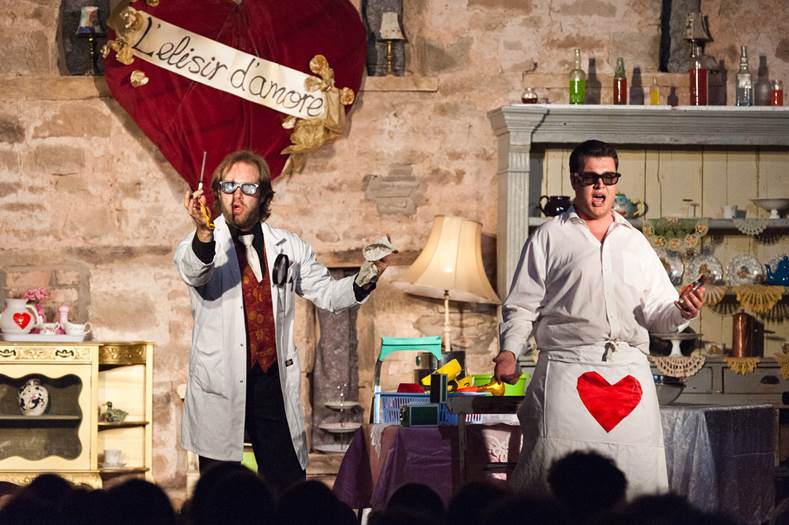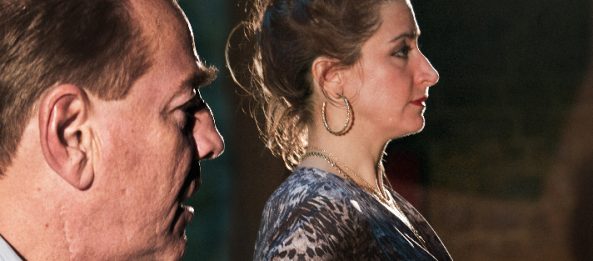Popup Opera present L’elisir D’amore at Blacks, Soho.
 As operas go, L’elisir D’amore stretches the viewer’s credibility surprisingly little, story-wise. Donizetti’s opera is a simple story of unrequited love which becomes requited, with merely a love potion, a flour magnate and a wealthy uncle to complicate things, which allows one to concentrate upon the music and the performance, both being worthy of our attention.
As operas go, L’elisir D’amore stretches the viewer’s credibility surprisingly little, story-wise. Donizetti’s opera is a simple story of unrequited love which becomes requited, with merely a love potion, a flour magnate and a wealthy uncle to complicate things, which allows one to concentrate upon the music and the performance, both being worthy of our attention.
Popup Opera specialise in unusual spaces, and this venue (a small room in a private club in Soho) is certainly that. Reminiscent of Studio 503, where I saw some wonderful Chekhov last year, the performers are almost literally in your lap. (Ricardo Panela, making his entrance as Belcore, tripped over my feet, looked at me and said “I’m sorry” and then started to sing). This close up view allows the audience to appreciate much that might go unnoticed in a larger space in terms of emotional acting, and also the ‘comedia’ style, which the company employ to great effect.
A common reviewer’s complaint is that it is difficult to single out individuals for special praise; in this case it is impossible: not because nobody stood out, but because everyone was outstanding. Cliff Zammit Stevens, as Nemorino (the only tenor role) played the lovesick young man to perfection and gave a piercingly beautiful rendition of Una Furtiva Lagrima (the opera’s most famous aria), despite performing it with a box of man-size tissues in hand. Ricardo Panela gave a commanding performance as Belcore, the pyramid flour salesman who almost wins the girl. Thomas Kennedy put his rich baritone and pantomime skills to excellent use as Dulcamara, the patent medicine man. Penelope Manser is a powerful soprano and talented comic, who really came into her own in the second act. Clementine Lovell was seemingly effortlessly delightful, charming and compelling both vocally and in terms of stage presence throughout as Adina. Add to that the fact that Clementine is also the producer (aided by assistant and extremely creative stage manager Fiona Johnston) and founder of the company, and my admiration is guaranteed.
 It is difficult in a small venue to keep the volume to a comfortable level while still keeping full passion and power in the voice, but all five of the singers managed this brilliantly. Musical director James Henshaw provided strong musical accompaniment which ranged from highly moving to, at times, having the flavour of a silent comedy movie. Harry Percival’s quirky captions also contributed greatly to the humour of the piece (they’re funny, yeah?). Darren Royston did a marvellous job, both as director and MC.
It is difficult in a small venue to keep the volume to a comfortable level while still keeping full passion and power in the voice, but all five of the singers managed this brilliantly. Musical director James Henshaw provided strong musical accompaniment which ranged from highly moving to, at times, having the flavour of a silent comedy movie. Harry Percival’s quirky captions also contributed greatly to the humour of the piece (they’re funny, yeah?). Darren Royston did a marvellous job, both as director and MC.
I think this is probably the best opera I’ve ever reviewed. Go and see for yourself, but be warned: there is audience participation (of a mild and unthreatening sort!)
L’elisir D’amore will be popping up at various venues around London throughout April. For more information visit popupopera.co.uk.
Mary Tynan
